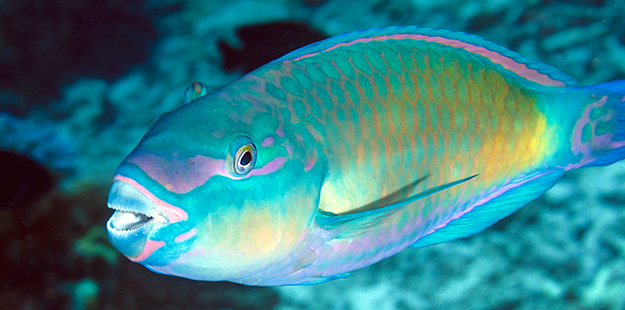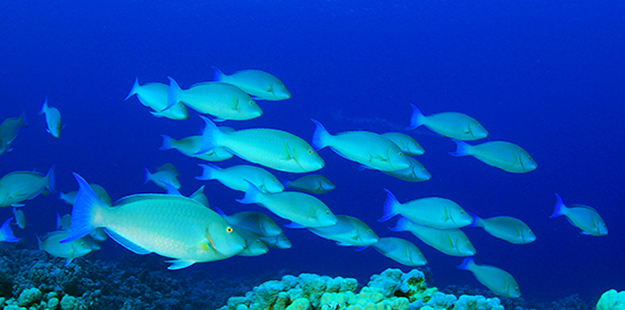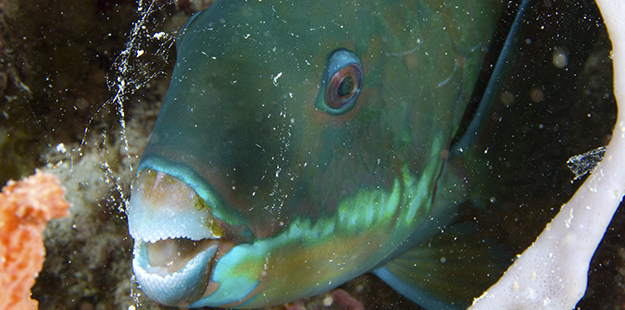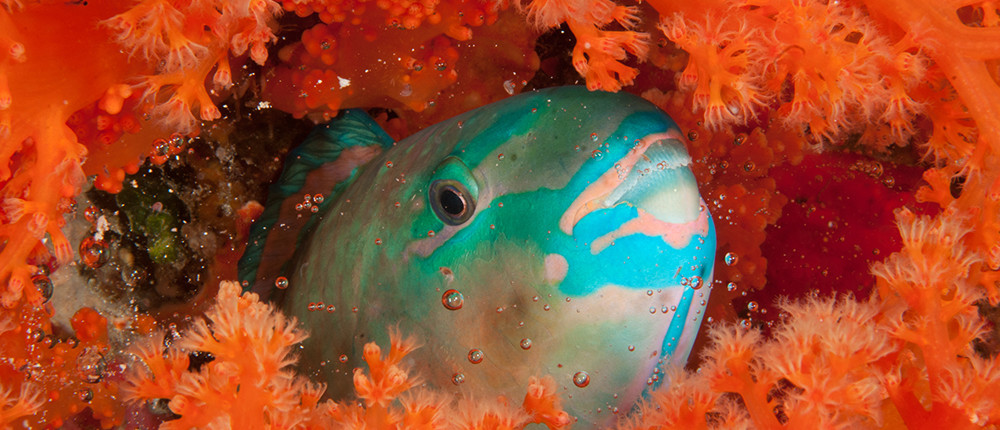The Beach Makers
A closer look at one of the most valuable but oft-overlooked fish on Wakatobi’s reefs
Of the thousands of species of marine life you may encounter at Wakatobi, none are more ubiquitous than the parrotfish. In fact, these relatives of the wrasses are among the most abundant and widespread species found on tropical reefs around the world. And that’s a good thing, because without parrotfish, the very health of the reef would be in jeopardy, and we humans might not be able to enjoy a walk on the beach. But we’re getting ahead of ourselves. Before delving into the benefits these fish provide the environment, let’s first find out a bit more about these often-overlooked but fascinating creatures.

On Wakatobi’s reefs you can find up to 35 species of parrotfish, including the bumphead, known for it’s larger size, bulbous forehead and exposed teeth plates, which are partially covered by lips. Photo by Wayne MacWilliams

Biologists once thought there were more than 300 species of parrotfish roaming the world’s oceans given their tendency to change coloration, shape and sex over the course of their lives. Photo by Paula Butler
Depending on which source you read, there are between 80 and 90 known species of parrotfish. At one point, the biologists thought there were more than 300 varieties swimming about the world’s tropical and sub-tropical regions. In defense of the academics, much of this confusion predated in-water observations and DNA testing, and is understandable, given these fishes’ propensity for changing coloration, shape and sex over the course of their lives. Attaching names to these underwater chameleons has resulted in some colorful titles. Midnight is an obvious choice for an all-black specimen, and there’s no mystery behind a red or blue parrotfish. But things get more interesting when you start searching for a rainbow, yellowtail, spotted, marbled, rivulated, greensnout or blue-barred parrotfish. Or, as an alternative to sorting out complex colorations, you could make your ID based on physical characteristics when looking for specimens such as the roundhead, longnose, raggedfin, steephead, heavybeak, spinytooth, knothead, or green humphead parrotfish. Finally, there are those varieties that apparently thwarted all attempts at logical classification, promoting the biologists to come up with more fanciful descriptions to bestow on the princess, queen, regal and festive parrots.
The better to pulverize
In Wakatobi waters, you can find up to 35 members of the parrotfish menagerie swimming about the upper portions of the reef, or venturing into the seagrass beds closer to shore. Parrotfish have large scales and are easily recognized by their distinctive beak-like mouths. A closer look reveals a row of tightly-packed teeth growing outside the jawbone. These teeth are the scrapers, which are used to gnaw and scrape on coral and rocks, either to remove algae or to actually loosen chunks of the coral itself. Deeper inside the parrotfish’s throat, a different set of molar-like teeth are used to pulverize ingested chunks of coral to extract embedded algae and polyps.

A closer look reveals a row of teeth growing outside the parrotfish’s jawbone, which are used to gnaw and scrape on coral and rocks, removing algae or to actually loosen chunks of the coral itself. Photo by Wayne MacWilliams
All this chewing creates a lot of wear and tear on the dental work, so parrotfish are constantly regrowing their teeth. Though algae make up a substantial portion of the parrotfish diet, these fish not strictly herbivores, They will feed on a range of reef organisms that can include sponges, zoanthids, worms and other small organisms that just happen to be at the wrong place at the right time. That said, it is their propensity for actually eating the reef that has earned them the greatest notoriety.
Parrotfish can’t actually digest the pulverized coral they create, and once the living organisms are extracted from the slurry, the remaining inorganic material is dumped overboard. Most anyone who has snorkeled or dove on a tropical coral reef has witness the periodic discharges of parrotfish. What they are actually seeing is the beginnings of a beach. The crushed coral generated by parrotfish is one of the primary components of beach sand in many parts of the world–including Wakatobi. So yes, when you are curling your toes in the sand, you are technically standing on… well, we think you can that figure that part out.
Before any of it washes ashore, the sand produced by parrotfish settles into the shallows to provide a substrate for burrowing animals. And even more important is the removal of algae from the reefs.
There’s some debate as to how much sand each parrotfish produces, with the most common number being somewhere in the range of 10 ounces/280 grams per day for the average size fish. That works out to about 220 pounds 100/kilos of sand per year, per fish. So when you see a school of a dozen fish or so grazing, you are looking at the equivalent of a dump truck load of sand production.
Beautiful beaches is only one example to just how valuable a parrotfish’s diet actually is for the environment. Before any of it washes ashore, the sand produced by parrotfish settles into the shallows to provide a substrate for burrowing animals. And even more important is the removal of algae from the reefs. Various studies have shown that the presence of parrotfish is one of the single most important contributors to the overall health of a coral reef.

When you see a school of a dozen parrotfish or so, you are looking at the equivalent of a dump truck load of sand production. Can you see the fish producing sand in the upper right corner of the image? Photo by Rich Carey
You might think of parrotfish as the lawn mowers of the reef, because when they are removed, the reefs become overgrown with algae. In many areas of the world, these fish are harvested for food, causing local populations to plummet. Fortunately, most species of parrotfish are not threatened with extinction on a world-wide level, and they are in plentiful supply in Wakatobi, thanks to the protects status of the reefs.
Give them a second glance
You are likely to encounter numerous species of parrotfish on most any dive at Wakatobi. They can range in size from 1 to 4 feet (30 to 120 centimeters) in length, with the largest being the bumphead and the bicolor. They often graze in schools, and if you stop and listen, you can actually hear them grinding away at the corals. If you are in the water near sunset, you may see these fish begin to scatter, each headed off in search of a sheltering section of the reef, where they can tuck themselves away and begin to secrete their signature cocoons. It takes a parrotfish about a half hour to create the mucous bubble that will become their bedchamber for the night. It’s thought that this membrane helps to protect the fish from predators by masking the parrotfish’s scent. Whatever the purpose, a cocooned parrotfish makes for an interesting snapshot during a night dive.

As sunset nears parrotfish will bed down and begin to secrete their signature cocoons, a mucous bubble that will become their bedchamber for the night. Photo by Walt Stearns
With so many exotic and unusual creatures awaiting discovery in Wakatobi waters, it would be easy to swim right by a parrotfish without giving it a second glance. Take a closer look, however, and you’ll realize there’s a bit more to the routine comings and goings of these fish than you might at first imagine. Simply getting a positive ID on many varieties can be a challenge, and they always make for willing and interesting subjects for fish portraits. If nothing else, pause for a moment the next time you encounter a parrotfish, and say “thank you” for that wonderful beach that helps to make Wakatobi such a special place.
Isn’t it time to experience all the Wakatobi has to offer? Contact us at office@wakatobi.com or complete a quick trip inquiry at wakatobi.com.
Visit us on Facebook.
View more great Wakatobi imagery on TUMBLR.


